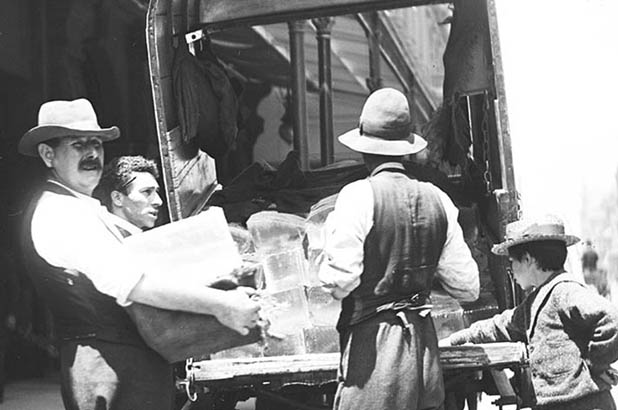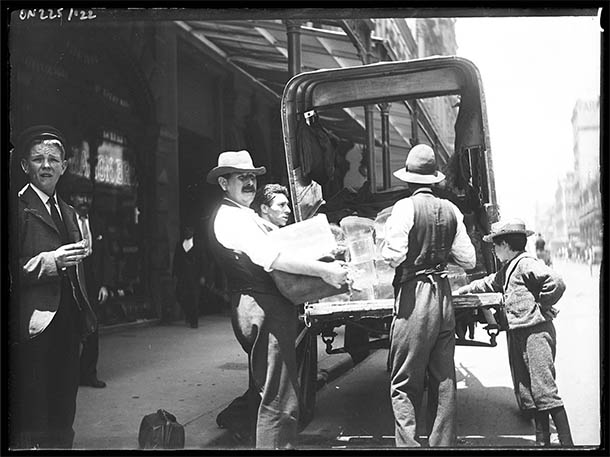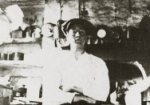Not everything was sold in corner shops. The familiar sounds of horse-driven carts and the street traders crying their wares were part of the rhythm of daily life at Susannah Place well into the 1950s. Fruit and vegetables, milk, rabbits, fish and bread were just some of the goods sold door to door throughout The Rocks and Millers Point in the 19th and early 20th centuries.
Milko, rabbitoh!
Ron Thompson, who lived at number 62 as a boy in the late 1930s, remembers the sing-song cries of the rabbitoh, the milko, and the fruit and vegie hawker announcing ‘peas, young and green’ and his lettuces having ‘hearts as big as heroes’.
His neighbour, Ray Gordon, who lived a few doors up from Susannah Place recalled:
The milkman and baker came around every day in a horse-driven cart. [There were] no milk bottles or cartons; the milk can was left on the doorstep overnight. Dealers came around selling fruit and vegies – usually obtained from the fruit markets in Haymarket. Rabbitohs would drive up the streets singing out ‘rabbitoh – rabbits for sale’.
The Rabbitohs’ legacy lives on as a Sydney entity with the South Sydney football team’s identity and logo.
Rabbit’s changeable reputation
Rabbit was a popular meat in colonial times – in Britain and in Australia – especially for curries (see recipe below), and colonists kept hutches with rabbits, bred for the table. Rabbits adapted readily to the Australian environment and were plentiful and cheap after their ‘release’ into the wild in the 1840s and they quickly spread across the country. This provided an opportunity for cash during the depression years in the 1930s – according to Ray Gordon, the rabbitohs would ‘catch the rabbits in the bush, skin them and sell them for six shillings each’. They’d have to be sold quickly, as some vendors’ carts had no refrigeration. Ron Thompson recalled ‘he used to chop their heads off and pull the skin off and the innards and that’. I can’t imagine many of us feeling too confident about buying our produce this way today!
During the war years in the early 20th century rabbit was not rationed as other meats were, and, becoming associated with times of poverty and dearth, lost its reputation as a sought-after alternative to red meat for generations of Australians.
Now, far from being a poor man’s meat, wild and farmed ‘white’ rabbit are found on many restaurant menus today.
![[Chinese carrying baskets, The Rocks, Sydney] Livingston Hopkins, 1886. National Library of Australia: nla.pic-an8870592 A Chinese man carrying baskets, walking down a street in The Rocks.](../../app/uploads/sites/2/2013/03/427x630xChinese-carrying-shoulder-baskets-The-Rocks-Sydney.jpg.pagespeed.ic.OmvnGtB4AY.jpg)
[Chinese carrying baskets, The Rocks, Sydney] Livingston Hopkins, 1886. National Library of Australia: nla.pic-an8870592
‘Nicely done up’
Jim Young remembers what a treat it was to accompany the baker on his early morning rounds in the early 1900s. All sorts of bread could be purchased, including rye bread (sometimes called black bread) to cater for the European population in the area.
Jim also remembered the regular fishmongers with ‘nicely done up’ carts who priced the fish according to size. Sometimes, when there was a glut of fish, non-licenced hawkers would seize the opportunity and hire a horse and cart to sell the fish cheaply and quickly.
Chinese hawkers selling fruit and vegetables from the market gardens in nearby suburbs carried their goods in the traditional way – across their shoulders in baskets suspended on the ends of a long bamboo pole.
Later, in the 1960s, Ellen Marshall remembered
We also had a greengrocer who came Friday around midday and stayed for half an hour in Gloucester Street. His name was Wally Jackson and he had a truck. He lived down the Point (Millers Point). He had good quality produce …
The iceman
The iceman was a regular and welcomed hawker, delivering large blocks of ice to keep domestic ice-chests cool. A precursor to the kerosene and later electric refrigerators, an ice chest was an expensive household item for working class families. Front doors were left unlocked so that the iceman could run straight into the kitchen and deposit the ice directly into the chest’s ice compartment and the payment for the iceman was often left on top of the ice chest – perhaps this is where that expression ‘leave your money on the fridge’ originated? Here is Jim’s description:
The ice was delivered each day first thing in the morning. The cart was tin enclosed. The iceman used to have a hessian bag and he’d wrap the block in a hessian bag and tuck it under his arm and run in with the ice and put it in the ice chest.
The iceman must have been something of a ‘pied piper’ in the summertime – local children would be given the bits of ice that were chipped off each block to suit the different sized ice chests.
Delivery revival
The suburban ice-cream van, with the familiar ‘Greensleeves’ tune announcing its presence, is one of the last remnants of the street-vendor and hawker era, but other echoes of the past are still with us. Fifty years on, delivery services are part of the big supermarkets’ fight for market share, aided by internet ordering, and a street-food revival has just kicked off in the city, with ‘tuck trucks’ popping up in public spaces, albeit selling ready-made foods rather than basic ingredients.
Rabbit curry
Ingredients
- 1 whole rabbit (about 1.2 kg; ask your butcher to joint it into 8 pieces)
- 3 tablespoons plain flour
- 2 tablespoons butter
- 1 onion, sliced
- 1 tablespoon curry powder
- 1 teaspoon beef extract (or stock cube or powder)
- 1 Large green apple, peeled and chopped
- 250g tomatoes, seeded and chopped (or use tinned tomatoes)
- 1/2 cup raisins
- 1 tablespoon chutney
- 3 tablespoons lemon juice
- 60ml (1/4 cup) pouring cream
- steamed rice, to serve
Note
Rabbit was a popular meat in colonial times, in Britain and in Australia, especially for curries, but it lost its place on our tables after World War II. The rabbitoh's cry might have been echoing when this recipe was spotted in the newspaper and stuck into Girlie Andersen's Golden wattle cookery book; the 'raisins and apples make [the curry] rich and fruity'. It could be a fun dish to serve on a weekend when the South Sydney Rabbitohs are playing on TV!
Serves 4
Directions
| Season the rabbit pieces with salt and pepper, and dust them lightly with 1 tablespoon of the flour. Heat the butter in a deep frying pan over medium heat and fry the meat for 8–10 minutes or until golden. Remove the meat from the pan and set aside. | |
| Add the onion, curry powder and remaining flour to the pan – adding more butter if necessary – and cook for a few minutes. Stir in 500 ml (2 cups) of water, and cook until the liquid boils and thickens, stirring occasionally to prevent the mixture sticking to the pan. | |
| Return the rabbit pieces to the pan and add the beef extract, apple, tomato, raisins and chutney. Cover the pan and cook over low heat for approximately 2 hours or until the rabbit is tender (a farmed rabbit may only need 1 hour). Add the lemon juice and cream, and stir through. Serve immediately with the steamed rice. | |


 Print recipe
Print recipe

